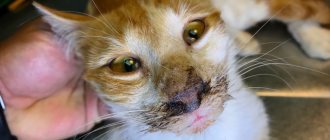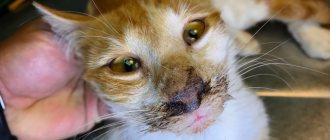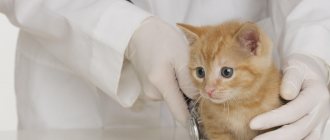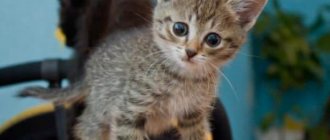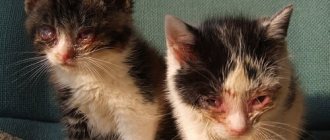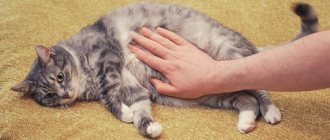Distemper in cats is a very dangerous disease. At the first signs of illness in a pet, the owner should seek help from a veterinary clinic so as not to miss the pathology and begin proper treatment in a timely manner.
One of the most dangerous diseases in cats is panleukopenia, or as non-specialists call it, distemper in domestic cats. Other names: parvovirus enteritis, infectious enteritis. The disease is widespread in nature. In addition to cats, minks, raccoons and ferrets can be carriers of the virus.
The virus affects all age groups, but kittens aged 2 to 12 months and old cats that have crossed the 8-9 year mark are more sensitive to it. The disease is transmitted from a sick animal to a healthy one through care items and bedding; grass contaminated with feces; with direct contact.
Cats living in an apartment can become infected through the owner's clothes and shoes. The virus can exist in the external environment for a year, so it is widespread and highly contagious.
Ways of infection of a kitten
Kittens can become infected in the same way as adult cats - through contact with the secretions of sick animals. Infection occurs both through direct communication and through the use of shared care items with patients and virus carriers. It is possible to introduce the virus from the street if the owner or animals that need walking have been in contact with infected feces. That is, the virus can be brought from the street on shoes, clothes, or wool.
The feline panleukopenia virus is widespread, so the likelihood of becoming infected with it, especially in large gatherings of animals (apartments with dozens of cats, poultry markets, etc.) is very high.
In adult cats, a latent form of the disease occurs, when the animal shows virtually no symptoms of the disease for a long time, as well as virus carriage. An apparently healthy animal can be deadly to a kitten.
Intrauterine infection is common in kittens: the virus from the body of a pregnant cat penetrates the placenta. Since the panleukopenia virus uses rapidly dividing cells to reproduce, it leads to severe pathologies of the fetus. As a result, kittens are born dead or nonviable.
Infection is possible after birth. Kittens aged 2-5 months are most vulnerable, but adolescents remain at high risk of the disease.
How is it transmitted?
The sources of this deadly disease are sick cats and virus carriers. Parvovirus is shed in stool (feces, urine) or saliva. There are several ways of contracting panleukopenia:
- During oral contact. The virus can enter the oral cavity along with saliva. More often this happens when drinking water or eating food infected with viral particles from a virus carrier or a sick animal.
- By airborne droplets. A healthy individual becomes ill with panleukopenia while in close proximity to a patient.
- By contact method. Infection occurs through personal belongings, clothing or shoes of the owner of a furry animal who has been in contact with a virus-carrying cat. In addition, parvovirus survives on litter trays, harnesses, bowls and toys for up to a year.
- In utero. The virus easily passes through the placental barrier and penetrates the fetus. Kittens infected at an early stage of pregnancy die (decompose inside, mummify) before birth or die 1-2 days after birth. Babies infected at a late stage often have congenital underdevelopment of the cerebellum.
- Transmissible method - when the causative agent of panleukopenia is carried by blood-sucking parasites - ticks, fleas, bedbugs.
Almost all representatives of the cat family can become infected with parvovirus: tigers, leopards, cheetahs. Among domestic animals, distemper is a widespread disease, to which unvaccinated kittens under one year of age and cats older than 6-8 years are more susceptible: young animals are predisposed to the disease due to undeveloped immunity, and older pets with age lose the ability to resist various viruses, because the immune properties of the body become weaker.
Pregnant cats and small kittens are also at risk of contracting panleukopenia. The chances of contracting plague increase in babies over two weeks of age. This is explained by the fact that the mother’s immunity weakens, and the baby’s own immune system is not enough to resist such a dangerous virus. If we consider breed predisposition, parvovirus is most dangerous for British representatives, Maine Coons, Siamese and Persian cats.
Is it dangerous for humans?
Panleukopenia is not dangerous to humans. They can only act as carriers of parvovirus on their outerwear, shoes and other things. Owners of several pets should be careful: if one cat has become infected with infectious enteritis, it must be isolated from a healthy cat and strictly quarantined. It is noteworthy that dogs are not afraid of the virus. Although they can get distemper, it can be caused by a completely different type of parvovirus.
Features of the course of panleukopenia in kittens
The disease is particularly dangerous even for adult animals, and among kittens the mortality rate reaches 90%. This is due, firstly, to the imperfection of the kitten’s immune system, secondly, to the body’s low resources, and thirdly, to the general immaturity of all organs and systems.
In kittens, the disease occurs in the vast majority of cases in an acute or even fulminant form. With the latter, the disease progresses in a few hours or less and always ends in death.
Owners may notice acute onset of diarrhea, and then the death of the animal occurs. In this case, all kittens that came into contact with the deceased are in danger, and it is necessary to urgently take preventive measures.
If a kitten in a litter suddenly dies, the first thing to be wary of is panleukopenia and start treatment for it. Once symptoms appear, it will most likely be too late.
The main symptoms of distemper in kittens
The classic picture of distemper in kittens looks like this. The animal suddenly loses activity, refuses food, and begins to experience diarrhea and vomiting. The discharge has a specific, extremely unpleasant odor. At this stage, owners usually confuse a viral disease with poisoning and therefore delay getting help.
Often, either the infection itself or the dehydration and intoxication caused by it lead to damage to the nervous system. In this case, kittens may experience circular (playpen) movements and convulsions.
Consequences and life expectancy of a cat
If symptoms of distemper in a cat are detected on time, then the negative consequences for the animal are minimized. Over time, body functions will be restored, and the pet will live a normal life. After the cat has overcome distemper, its body will produce antibodies to this disease and the likelihood of illness will be reduced to a minimum. Timely diagnosis of the disease has a positive effect on life expectancy.
If the form of the disease is fulminant, and it is not possible to diagnose the disease in time, the consequences for the animal can be severe. Often, animals that have had severe enteritis experience heart and pulmonary failure and problems with digesting food. The consequences oblige the owner to put the cat on a diet and monitor its nutrition and weight throughout its life. Restrictions will help your pet live a long, quality life.
Diagnosis of panleukopenia in kittens
The stages of diagnosing panleukopenia in kittens are the same as in adult animals: general examination, tests for virus content, clinical blood test. However, the difficulty of testing in kittens is to take the required amount of blood. Animals are already dehydrated, and their hematopoietic system suffers. It is not always possible to draw blood even when an intravenous catheter is placed. It is possible to collect from the jugular vein, but this manipulation requires specific skills from the doctor and is not performed by all veterinary specialists.
PCR diagnostics (detection of panleukopenia virus DNA) in kittens is necessary if an express test is not available. The analysis takes 2-3 days, and there is a chance that the animal will not live to see the result. But it is necessary to know the cause of the disease, because more than once in veterinary practice there have been cases when owners brought dying kittens to the clinic one after another: 2-3 months after the death of the pet, they took in a new animal, and at home it became infected with a fatal disease from its predecessor.
The panleukopenia virus is extremely stable in the external environment; it remains viable for up to 1 year. Therefore, it is unacceptable to take a new cat into the house without antiviral treatment of the premises and objects.
Modern rapid tests are almost as accurate as PCR. Suitable material for both methods is stool or intestinal washings, which allows you to collect less blood for analysis or delay blood testing if collecting it is difficult due to the patient's serious condition.
Prevention
Owners of furry pets should definitely know what methods exist to prevent such a terrible disease as distemper. To do this you need to know a few rules:
- If there are several cats in the house, the uninfected animal should be given to friends or placed in a nursery during the treatment of the sick one.
- If after three weeks of the incubation period the disease has not manifested itself in other pets, they must be vaccinated.
- It is advisable to vaccinate a cat at an early age - when the kitten is 2 months old, after which it needs to be revaccinated after 3 weeks.
- Adult cats from one year of age must be vaccinated annually, and pregnancy is a contraindication to vaccination.
Today there are vaccines that stimulate the production of intense immunity in animals, which lasts for a year. It is important to remember that only an absolutely healthy cat that has been treated for external parasites and helminths can be vaccinated. Vaccination is recommended with the following drugs:
- Quadricate;
- Multifel;
- Nobivac;
- Felocel.
What can panleukopenia be confused with?
Firstly, with poisoning. An important difference between panleukopenia and poisoning is that with this disease, at the initial stage of the disease, the animal’s body temperature rises significantly, up to 40-41 degrees and above. In case of poisoning, the temperature is normal or low. However, kittens quickly enter the second phase of the disease - exhaustion of the body, during which the temperature drops. In this case, only a veterinarian can distinguish between these two conditions.
Secondly, with acute toxoplasmosis. Most often, this infection is carried by cats asymptomatically, but in kittens it is difficult to distinguish between these two infections by symptoms. This is where express analysis or PCR comes to the rescue. Toxoplasmosis in kittens, although severe, is less dangerous than panleukopenia. There is a specific treatment for this disease, that is, drugs that kill the pathogen.
Thirdly, with pancreatitis, acute gastroenteritis of non-viral nature and other diseases of the gastrointestinal tract. With these diseases, the temperature may rise, but the pathogen will not be identified, and in small kittens they are all quite rare.
Treatment of distemper in kittens
The most effective treatment for distemper in kittens is in a hospital setting. Such patients require round-the-clock monitoring by a veterinarian, monitoring body temperature, dehydration, heart and lung function.
At home, removing distemper-stricken kittens is a task for extremely experienced owners with veterinary skills and a lot of free time. This is not the case when you can leave a sick animal at home and calmly go to work or even for an hour or two on business.
Treatment consists of replenishing the deficiency of fluid and minerals, administering vitamin preparations, antibiotics to prevent secondary damage to the animal by bacterial microflora. Drugs are used to support the functioning of the heart, respiratory and nervous systems. Gastroprotectors are also necessary - medications that reduce the acidity of gastric juice, protecting the digestive tract from the secretions it produces.
Antiemetics are also needed, and not the usual metoclopramide (Cerucal), but the more expensive Serenia. The fact is that metoclopramide stimulates intestinal motility, and this can lead to diarrhea or, worse, intestinal obstruction due to the fact that the inflamed intestine does not adequately respond to stimulation.
Ideally, a specific immunoglobulin against panleukopenia is administered, for example, Immunovet In-1. Such drugs are used both for animals that are already sick and for those who are likely to come into contact with the virus.
Despite numerous speculations around drugs in this group, evidence-based veterinary medicine recognizes the effectiveness of the method. Questions arose regarding specific medications. Those of them whose effectiveness was questionable are now not produced or sold.
What should a doctor do if he suspects feline distemper?
To make a correct diagnosis, the doctor must:
- He will ask the owner in detail about the first manifestations of the disease.
- Measure the temperature or ask the cat's owner to do so before his visit.
- He will examine the mucous membranes and ask when the cat last drank.
- Note whether there are fibrin flakes or blood in the liquid stool.
- Pay attention to the cat's behavior and the position in which he sits (lies).
- An external examination is required - cachexia (exhaustion), dry skin, condition of the coat.
- Feels the lymph nodes.
- Listen to the lungs for incipient pneumonia and heart sounds.
- He kneads the cat’s belly with his hands, establishing the degree of intestinal soreness and palpating its loops.
At the end of the examination, the doctor will already have an almost exact idea whether the cat is suffering from “distemper” and will already prescribe medications to alleviate the general condition of the sick animal.
However, for a complete picture, the doctor will need additional laboratory tests (hematological, histological and virological) to differentiate from toxoplasmosis and alimentary enteritis.
Next – follow the veterinarian’s instructions as accurately as possible!
